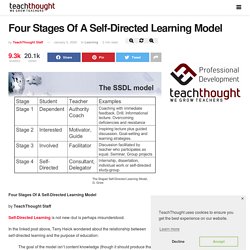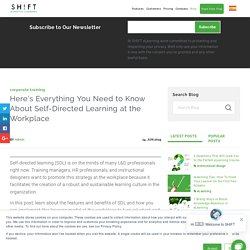Zoom
Trash

What is Self-Directed Education? The revolution of self-directed learning. The Four Stages Of The Self-Directed Learning Model. Four Stages Of A Self-Directed Learning Model by TeachThought Staff Self-Directed Learning is not new–but is perhaps misunderstood.

In the linked post above, Terry Heick wondered about the relationship between self-directed learning and the purpose of education: The goal of the model isn’t content knowledge (though it should produce that), but rather something closer to wisdom–learning how to learn, understanding what’s worth understanding, and perhaps most importantly, analyzing the purpose of learning (e.g., personal and social change). It also encourages the student to examine the relationship between study and work–an authentic ‘need to know’ with important abstractions like citizenship and legacy. Studied in terms of adult education and vocation for years, self-directed learning is increasing in popularity for a variety of reasons, including growing dissatisfaction with public schooling, and the rich formal and informal learning materials available online. Learner Teacher. The Nature of Self-Directed Learning. Folks: The posing below is a nice overview of the nature of self-directed learning.

It is from Chapter Four - Self-Directed Learning, in the book, Theory and Practice, by Sharan B. Merriam and Laura L. Bierema. Published by Jossey-Bass, a Wiley Brand. Regards, Rick Reis reis@stanford.edu UP NEXT: Reading Guides Rediscovered. Moodle. Self-directed learning (SDL) is on the minds of many L&D professionals right now.

Training managers, HR professionals, and instructional designers want to promote this strategy at the workplace because it facilitates the creation of a robust and sustainable learning culture in the organization. In this post, learn about the features and benefits of SDL and how you can implement this learning model at the workplace to turn reluctant and dispassionate learners into dedicated and inspired ones. Adult learners are mature, responsible individuals who want to take charge of their own learning. This is a natural psychological and cognitive development that takes place as human beings mature intellectually (Knowles, 1975).
In this respect, the concept of SDL is a cornerstone of adult learning because it taps into a natural human behavior. SDL includes knowing what you need to learn, how to learn it, and being able to judge if you’ve learnt it. Let's take a look: Additional reads: Let's take a look: Why Self-Directed Learning Is Important for Struggling Students. The term “at risk” is loosely defined and using it as a umbrella descriptor for struggling students is a slippery slope.

At my suburban school in South Carolina, the term is used liberally to describe students who may fail the End of Course Tests, students who might not get promoted to the next grade level and those at risk of dropping out of school. After three years working with this student population, I can say with confidence that it’s a loaded term and its overuse often causes it to become a self-fulfilling prophecy for kids who can be successful. The problem is that as an educator, my natural inclination is to provide these students more direct instruction, increased support and even hand-holding at times—but in a society that values individuals who are motivated, persistent self-starters with initiative, that’s not fair.
I teach four sections of a reading seminar for first time freshman who have low MAP reading scores from eighth grade. Alliance for Self-Directed Education. Education that derives from the self-chosen activities and life experiences of the person being educated.

Let’s start with the term education. In everyday language people tend to equate education with schooling, which leads one to think of education as something that is done to students by teachers. Teachers educate and students become educated. Teachers give an education and students receive this gift. But any real discussion of education requires us to think of it as something much broader than schooling. Education can be defined broadly in a number of ways. It also includes some culture-specific skills, such as, in our culture, how to read, how to calculate with numbers, how to use computers, maybe how to drive a car—the things that most people feel they need to know in order to live the kind of life they want to live in the culture in which they are growing up.
Next: The Four Educative Drives. Self-Directed Learning: A Four-Step Process. Metacognition: Relevance to Instructional Design on JSTOR. Activities for Metacognition. Metacognition, or thinking about one’s thinking, is key to facilitating lasting learning experiences and developing lifelong learners.

Linda Darling-Hammond and her colleagues (2003) identify two types of metacognition: reflection, or “thinking about what we know,” and self-regulation, or “managing how we go about learning. " Metacognitive activities can guide students as they: Identify what they already know Articulate what they learned Communicate their knowledge, skills, and abilities to a specific audience, such as a hiring committee Set goals and monitor their progress Evaluate and revise their own work Identify and implement effective learning strategies Transfer learning from one context to another Activities that promote metacognition should: Facilitate equal participation Ensure students do most of the talking Take place before, during, and after an experience Happen in different group configurations (individuals, pairs, small group, large group) What is it?
Good for: A Focus on Teaching: Metacognition.